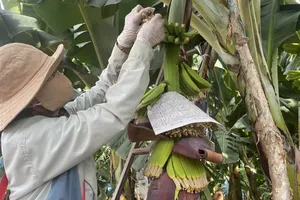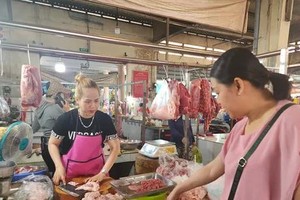Without timely support, domestically produced goods risk being overwhelmed in their own market, posing significant challenges for the national manufacturing sector.

Domestic market overwhelmed by cheap imports
At the CEO Forum 2025 recently organized by Sai Gon Giai Phong Newspaper in collaboration with the Ho Chi Minh City Institute for Development Studies (HIDS) and the Ho Chi Minh City Business Association (HUBA), Chairman of HUBA, Nguyen Ngoc Hoa pointed out an alarming fact that in the first 4 months of 2025, the number of businesses withdrawing from the market was nearly half of the whole year of 2024.
Businesses' resilience is being significantly weakened. This is no longer a temporary issue but has persisted for many years.
According to the HUBA Chairman, one of the corrosive factors is the flood of cheap goods from countries in the region. In the context of the US and the European Union (EU) imposing trade barriers on China, goods from this country are rushing to find their way into secondary markets, including Vietnam.
Many consumer goods, industrial materials, and processed foods are priced 20 percent-40 percent lower than Vietnamese products. While domestic consumers are still tightening their spending, this price gap has become a key factor influencing purchasing decisions, putting Vietnamese goods at a competitive disadvantage. Cheap consumer products are flooding both traditional markets and e-commerce platforms.
Chairman Pham Van Viet of Viet Thang Jean Company noted that Vietnam’s textile and garment industry comprises approximately 11,000 enterprises, with around 6,000 being household businesses. These largely rely on traditional labor, with only about 6 percent having adopted semi-automatic or automatic production.
Meanwhile, China’s large-scale production and advanced technology enable strong price competition. For instance, processing costs in Ho Chi Minh City are US$2.2 per product and $1.9 in Hanoi, but in China, the same product costs only $1.7 due to cutting-edge technology. Additionally, affordable local raw materials and efficient logistics further lower the prices of imported goods compared to domestic products.
Data from the Ministry of Finance's General Statistics Office shows that the import turnover of goods in the past 5 years has increased steadily every year. In the first 5 months of 2025 alone, total import turnover reached more than $170 billion, an increase of more than 18 percent compared to the same period in 2024. Notably, the consumer goods group accounted for more than 6 percent of the total turnover, showing that imported goods, especially cheap goods, are increasingly dominating the domestic market.
Timely, practical and flexible support
Facing these challenges, many businesses, particularly small and medium-sized enterprises, voiced their opinions that they cannot overcome difficulties without the Government's timely, practical, and adaptable support mechanisms. Chairman Nguyen Ngoc Hoa suggests that the State should categorize businesses by size and tailor policies for each group, rather than applying uniform measures as using the same policies for large corporations and micro-businesses is unfair, he stated.
A major obstacle is access to capital. Banks still demand collateral, which small businesses often lack. HUBA proposes open credit ratings to allow businesses with strong credit histories to borrow without collateral. Additionally, establishing regular public-private forums for each industry is essential to address challenges collaboratively, enabling businesses to adapt to a rapidly changing environment without struggling alone.
In particular, as the costs of complying with ESG (environmental, social, and governance) standards, the Carbon Border Adjustment Mechanism (CBAM), inspections, and logistics continue to rise, it is essential to develop shared infrastructure—such as centralized inspection centers, communal cold storage facilities, and integrated e-commerce platforms. These resources can help small and medium-sized enterprises (SMEs) lower operating costs, which is the most effective way to reduce input expenses and foster sustainable competitive advantages for Vietnamese products.
Additionally, Chairman Nguyen Anh Duc of the Vietnam Retailers Association emphasized the need to restructure the domestic market to prioritize Vietnamese goods. Modern distribution networks—from wholesale markets to supermarkets—should implement policies that give preference to locally made products. Enterprises like SATRA, Saigon Co.op, and BRG Group are expected to lead the effort in building a robust Vietnamese consumer ecosystem.
General Director Lam Quoc Thanh of Saigon Trading Group Limited (SATRA) noted that the company is expanding its retail footprint, strengthening supply-demand linkages, and investing in digital transformation to bring domestic goods to consumers more quickly and efficiently.
Domestic consumption stimulus programs need to be implemented more robustly. Increasing public spending, temporarily reducing value-added tax for domestically produced goods, and organizing Vietnamese product fairs across regions are urgent measures to “pump vitality” into the domestic market, helping businesses generate revenue and cash flow for reinvestment, said Chairman Nguyen Anh Duc.
If timely action is not taken, Vietnamese goods risk not only losing their foothold in international markets but also being pushed out of the domestic market. Therefore, a comprehensive strategy is needed, combining policy, credit, distribution, and communication efforts to 'liberate' Vietnamese goods from their current predicament, restore market confidence, and create new momentum for national production.
























